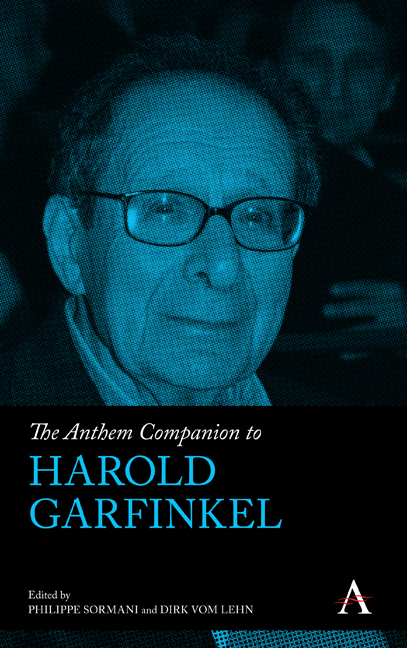Book contents
- Frontmatter
- Contents
- List of Illustrations
- Introduction: Rediscovering Garfinkel's “Experiments,” Renewing Ethnomethodological Inquiry
- Part I Exegesis
- Part II ‘Experiments’
- Part III Implications
- Postface: “Experiments”—What are we Talking About? A Plea for Conceptual Investigations
- Notes on Contributors
- Index of Names
- Index of Subjects
Chapter Five - Notes on Galileo's Pendulum
Published online by Cambridge University Press: 28 February 2024
- Frontmatter
- Contents
- List of Illustrations
- Introduction: Rediscovering Garfinkel's “Experiments,” Renewing Ethnomethodological Inquiry
- Part I Exegesis
- Part II ‘Experiments’
- Part III Implications
- Postface: “Experiments”—What are we Talking About? A Plea for Conceptual Investigations
- Notes on Contributors
- Index of Names
- Index of Subjects
Summary
Under the streetlight, a man was looking for something. Another man saw his effort and asked him what he was looking for, to which the other man responded that he was looking for his keys but can't find them. “Are you sure you lost them here?” “Well, I lost them in the dark part of the street.” “So, why are you looking here?” “Because here is the light.”—Epistemics’ joke
Galileo opened the “Dark Ages” to the first ray of light with the pendulum. To use a thing as the instrument to demonstrate mathematical models as analytical foundations of all things’ causalities, Galileo invented the thing-“world” as a pair of two methods: one, of formal analysis (FA), the other, the unaccounted in situ and in vivo work with the scientific instrument, such as a pendulum. About the two methods, Harold Garfinkel observed, “just this equipment speaks of the transcendentality and universality of methods and results as local, practical achievements” (Garfinkel 2022, 35). Galileo's pendulum pairs concrete and universal technologies of accounts as two incommensurable asymmetrically alternate types of “absurdity of accounts”—formal analytical (FA) and ethnomethodological (EM).
Within the EM corpus of work, these notes on Galileo's pendulum belong to “hybrid studies of work.” The “hybrid studies of work” render a possibility of an EM account of Galileo's pendulum in the very methodological “loophole” in FA through which the concreteness of things escapes. The relation between the two methods, Garfinkel captures with a metaphor of a mythological monster of two Janus faces (FA and Ethnomethodology, EM) as two incommensurable, asymmetrically alternate technologies of social analysis.
The import of the two Janus faces of the objective reality of social facts is this: The literatures of the indefinitely many analytic arts and sciences of practical action and practical reason, by reason of formal analytic procedural definiteness of demonstrated order in things, provide and assure the existence of an observable and instructably witnessable absence of things. (Garfinkel 2002, 103)
“Hybrid studies of work” refer to “mythological” accounts and accountability as in the pairing of two Janus faces, ﹛ ﹜. As each Janus's face considers the other face's sight[ed] absurdity—“There is no order in the plenum” versus “There is order in the plenum”—each account is absurd to the other account.
- Type
- Chapter
- Information
- The Anthem Companion to Harold Garfinkel , pp. 83 - 96Publisher: Anthem PressPrint publication year: 2023



